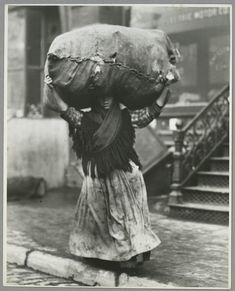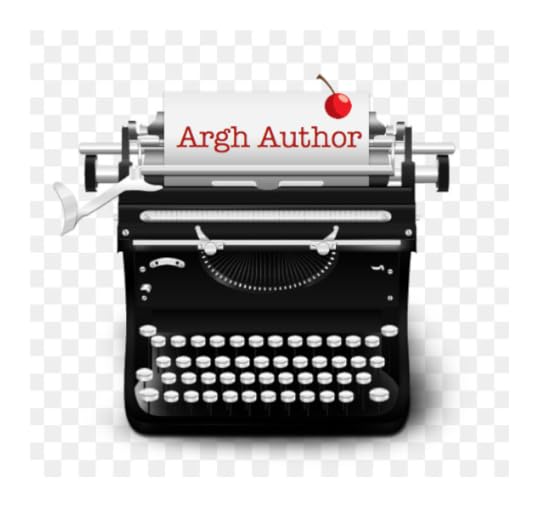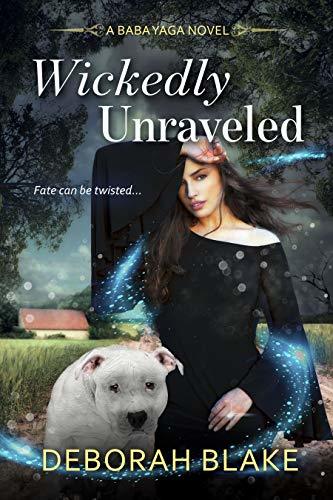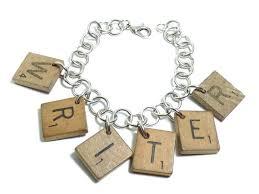Jennifer Crusie's Blog, page 158
April 19, 2019
Questionable: Is Collaborating on a Novel a Good Idea?

Danielle asked:
A friend recently approached me about collaborating. I think we could be great together but she is not a writer. She is a devoted reader and I trust her judgment. . . . What advice or resources would you have for someone taking on a partner? I don’t think she’ll be interested in the grunt work but in the plotting and world building.
In your case as described, I would strongly advise not to. In fact, run away.
There are partnerships where one researches and one writes—Ellery Queen comes to mind—but almost inevitably the one doing the writing does 95% of the work and gets half the money and then things blow up. If you do decide that you’ll do the writing and she’ll do the plotting and research, make sure you get the lion’s share of the money, at least 75% and probably 90% and then only if she does allthe research and plotting.
But that means that you’re going to let somebody else plot the book you write, which means you’re giving up a lot of control. In fact, you’re basically ghost-writing her story. That only works if she’s James Patterson (and even then you’re still going to get a fraction of the money for doing most of the work). But if she has no name to sell the book, you’re both going to work on the plotting, and then you’re going to write it? She’s a good friend. Mention her in the acknowledgements and buy her a nice dinner when the book comes out. Helping with plotting is what a critique partner does for free, not what a writing partner does. A writing partner writes. If she’s not writing half the book, she doesn’t get half the money. If she’s not writing any of the book, she’s not collaborating and she doesn’t get any of the money.
(You would not believe how many times people have come up to me at book signings and said, “I’ve had a fascinating life. I’ll tell you about it, you write it, and we’ll split the money.” I smile and say, “No.” But I’m thinking, “HELL, no.”)
My collaborations have mostly been with great partners—hardworking, open to suggestion, creative and cooperative, writing an equal share of the story—and it was still difficult. A collaborator who doesn’t write? Nope. Nope, nope, nope. If I’m going to write the whole book, I’m going to get the whole check.
Katrinawrote:
Two questions: does your writing process change in your collaborations and even though you’ve collaborated with a few people more than once, (Krissie, Bob) was it a different process each time?
Well, we got better each time.
The process for all my collaborations (not for collaborations in general) was that we each took a character and wrote that character’s arc and plot. That is, Bob took the Guy and I took the Girl and we negotiated from there, but he wrote all the Guy’s PoV and I wrote all the Girl’s. With Krissie, it was the same thing, except there were three of us in each collab (Eileen Dreyer in the first one and Lani Diane Rich in the second) and we each took a female PoV. In The Unfortunate Miss Fortunes, Eileen took the oldest, bossy sister, Krissie took the peacemaker middle sister , and I took the youngest rebel sister. In Dogs and Goddesses, I took the oldest jaded college professor, Lani took the middle practical tech expert, and Krissie took the youngest dreamy romantic. Because all the characters were deliberately so different (and so reflective of who we were) it was easy to put them together in a book, which is not to say that collaborating is easy. It isn’t; it’s much harder than writing solo.
The writing process changes when I change collaborators because their personalities and writing processes are very different. Writing with Bob is miles different from writing with Krissie. Not better, not worse, just different. The real key is finding a collaborator who has the same vision for the story that you do (that involves a lot of discussion beforehand), has the same work ethic you do, and who is open-minded about change. One of they key rules we always had was that we got say over our character’s dialogue and action in the scenes that others wrote. If your collaborator says, “This bit you wrote won’t work for my character, she wouldn’t say or do this,” find out why, and let her make the changes, even if it means losing something important to you. And vice versa, of course.
If you get a collaborator who tries to dictate to you, or who decides to take a vacation in the middle of the book, or gets angry and lets that take over his or her side of the book, then you’ve got a major problem. Choose your collaborators carefully. Now that I think about it, Bob and Krissie are both so open-minded that I should have known in advance it would work out. (Bob and I had some non-writing fights, but any time we hit a wall in the book, we just talked it out.) I’m not sure my collaborators would say the same about me, but I was fortunate in how flexible they were.
Collaborating is cooperating. I remember on UMF, Eileen was insistent that the local diner served martinis and I was insistent that it did not (no local diner I had ever been to was organized enough for a liquor license or wanted a bunch of drunks in the booths). My compromise was writing in that the diner was under new management and the new manager was an idiot and was serving martinis. It actually fit well into the plot—the new manager was a minion of the Big Bad who was not happy about those martinis—and Eileen got the scene with martinis in the diner that she needed to make her plot work.
Krissie and I were laughing the other day about her mattress in D&G; she’d had her very petite character wrangle a queen-size mattress onto the top of her station wagon, drive it back to the place she was staying, and haul it up a flight of stairs that had a turn in the middle. Lani and I said, “No, she didn’t,” and while Krissie was explaining she was sure that was possible, Lani and I (people who had actually wrangled queen-sized mattresses) said, “Nobody will ever believe it.” She finally gave up and made it work a different way. And there was the time Krissie and Lani told me there wasn’t enough passion in a sex scene and harassed me until I went back and rewrote, which lead to the creation of our term for a great sex scene: “Dick and Awe.” And we also dinged Lani for wimping out on a sex scene in a courtyard by saying repeatedly for weeks, “That’s the courtyard where nobody ever has sex” until Lani gave up and wrote a sex scene there. We had a good time on that collaboration.
On the whole, I don’t recommend collaborating because you get half or a third of the money and you lose control over any part of the story that isn’t yours. It’s much harder than writing solo, although there are some great rewards, including learning a lot from the people you’re collaborating with. Hard to believe I didn’t know what a double tap was before I met Bob.
The post Questionable: Is Collaborating on a Novel a Good Idea? appeared first on Argh Ink.

April 18, 2019
This is a Good Book Thursday, April 18, 2019
I think my reading mojo is off. I seem to be obsessively re-reading instead of looking at the new books I have. Comfort reading, even though the days here are now beautiful and sunny, and taxes are over, and there’s nothing stressful on the horizon except finishing my damn book. And yet . . .

What did read this week that was comforting? Or interesting? Or exciting? Or just plain good?
The post This is a Good Book Thursday, April 18, 2019 appeared first on Argh Ink.

April 17, 2019
Working Wednesday, April 17, 2019

I’m working, but I don’t seem to be getting anywhere.
Where are you getting to on your stuff?
The post Working Wednesday, April 17, 2019 appeared first on Argh Ink.

April 16, 2019
Argh Author: Deborah Blake’s Wickedly Unraveled

Our own Deb Blake is is the author of the Baba Yaga Series from Berkley (Wickedly Dangerous, Wickedly Wonderful, Wickedly Powerful), the Broken Rider Series, and has published nine books on modern witchcraft with Llewellyn Worldwide. Her latest novel, Wickedly Unraveled, is out now. Oh and there’s this from Deb: “I’m doing a huge giveaway over on my blog to celebrate. Check out all the goodies! There’s even a Fire tablet. So hurry on over to http://deborahblake.blogspot.comto enter.”
And now, more about Wickely Unraveled . . .

Barbara Yager is used to traveling alone as she tends to her duties as a Baba Yaga. She sometimes brings Babs, the adopted daughter she is training, but her sheriff husband stays behind. This trip, though, she has made an exception. After all, the task seems so simple, and shouldn’t take long to accomplish. When it is done, the three of them can indulge in a long-overdue family vacation. What could it hurt?
Quite a lot, as it turns out. What Barbara thought was a minor problem ends in a violent magical confrontation she never expected. The resulting backlash sends them all into a warped timeline where Barbara and Liam never got together, and only Barbara and nine-year-old Babs remember the truth. Liam is still trapped in his grief and all the good they’ve done together in the past few years has come undone.
Even worse, her Baba Yaga sisters, Beka and Bella, don’t believe her, and the wicked Brenna is still out there, planning who knows what kind of mischief. The children stolen by the rusalka Maya are trapped in the Otherworld and she is loose in this one and up to no good. It is up to Barbara, Babs, and their faithful dragon-dog companion Chudo-Yudo to knit together the unraveled timeline and make things right again, before it is too late and Barbara loses her one true love forever.
Find Deb’s books at Barnes & Noble |Amazon |Kobo|iTunes|Amazon Print
Also, there’s lots to know about Deb. When not writing, she runs The Artisans’ Guild, a cooperative shop she founded with a friend in 1999, and also works as a jewelry maker, tarot reader, and energy healer. She lives in a 120-year-old farmhouse in rural upstate New York with three cats who supervise all her activities, both magical and mundane. Find out even more about Deb at the links below:
Newsletter: http://dld.bz/dWEQs
Twitter: http://www.twitter.com/deborahblake
Facebook: https://www.facebook.com/deborah.blake
Blog: http://deborahblake.blogspot.com/
Website: http://deborahblakeauthor.com/
Goodreads: https://www.goodreads.com/author/show/246753.Deborah_Blake
The post Argh Author: Deborah Blake’s Wickedly Unraveled appeared first on Argh Ink.

April 15, 2019
Questionable: How Do You Move a Story Through Time?
Colognegrrl asked:
I am presently working on a manuscript that has been giving me hell. I know where I’m coming from and where I want to end, but in between are a lot of problems. The main challenge is to fill the time gaps, you know like “this scene is on Sunday and the next important thing happens on Thursday, but what did she do in between? She must have met the guy, she must have done this and that, it’s too boring to tell but how do you take the reader from Sunday to Thursday …?”
This is called a segue and it’s used all the time. The easiest way is to dump everything into a clause:
“For the next five days, Jane tried to pretend she didn’t care, throwing herself into her work, but on Thursday . . . “
If stuff happens during that time, you may need a full sentence:
“Jane snapped at her mother on Sunday, savaged a client on Monday, kicked a dog on Tuesday, wept helplessly at work on Wednesday, and then fired her assistant on Thursday when he said, ‘This has to stop.’ Except he was right, so she rehired him and then that afternoon went to see Richard.” Worst case scenario: It takes an entire paragraph as summary.
The key is to find out if there’s any info in that five days that must be on the page. If there isn’t, stick with the basics:
“Five days later, Jane . . . “
The post Questionable: How Do You Move a Story Through Time? appeared first on Argh Ink.

April 14, 2019
Argh Happy

I was just thinking about how happy the comments on Argh make me. You know the ones I mean: about working on the garden at the new house, about having lunch with the daughter, about watching the little one help his baby brother walk, about meetings with nieces and old friends, about powering through problems and keeping on going no matter what and being grateful for the family and significant others that are always there. I treasure the Argh people, all of you, but I also love the extended world connected to you, connections full of joy and comfort and laughter, good food and good gardens and good books and good times. I am so grateful to you all for sharing all of that here. Makes me all warm inside. Thank you.
What made you all warm inside this week?
The post Argh Happy appeared first on Argh Ink.

April 13, 2019
Cherry Saturday, April 13, 2019

Today is Scrabble Day, celebrating a brilliant game that’s now so iconic they make jewelry out of vintage pieces (has to be wood tiles, not the plastic). What other game demands the use of a dictionary and a million ways to use Q and X? I wouldn’t even know what “qi” meant without Scrabble. Best game ever (although Clue runs a close second for many reasons I will not go into here).
Happy Scrabble Day!

The post Cherry Saturday, April 13, 2019 appeared first on Argh Ink.

April 12, 2019
Questionable: How Do You Start and Develop Subplots?

K asked:
Do you start out knowing all of the subplots? Or do they tumble and bump into each other along the way? Are there certain ways you like to develop subplots? Or do they just come to you? Are they villain driven?
As I believe I’ve said before, I don’t recommend my method. I never know what the hell I’m doing in the beginning. I just write. Characters show up. Some of them are interesting enough they develop their own plot lines. Some of those I have to put the kibosh on because they’re cluttering up the story (good-bye, Mort). Some of them echo the main plot or act as a foil to the main plot, and they deepen what’s happening in the story as a whole, so I keep them (hello, Max and Button). So for the first discovery draft, I just let them happen. After that, as always, I analyze. And to analyze I go back to basic plot structure.
Subplots, like main plots, are protagonist driven and antagonist shaped. (To your question “Are they villain driven?”, if the antagonist drives the plot, he or she is not the antagonist, he or she is the protagonist.) But subplots have another function: they act as echos or foils to the main plot, deepening it by either showing another aspect of its thesis or showing a contrast to it.
Example: In Faking It, Tilda and Davy are both trying to go straight, but in order to keep Tilda out of jail, they both have to go back to conning people including each other. That screws with their relationship, and they can’t straighten it out until they tell each other the truth. Meanwhile, Tilda’s sister Eve and Davy’s friend Simon have a great sex life because they’re lying in their teeth to each other; their fantasies are what fuel their passion. So when Eve finally tells Simon the truth, he ends their relationship, his fantasy destroyed, and Eve is furious with him when she learns his truth, her fantasy destroyed. That Eve/Simon subplot is a contrast to the Tilda/Davy main plot because the Tilda/Davy relationship is built through working together and understanding each other and finally trusting each other enough to tell the truth; whereas the Eve/Simon relationship can only last as long as they lie to each other. The Eve/Simon subplot is necessary to the story as a foil for the main plot. (Tilda’s antagonist is Clea; Eve’s antagonist is Simon.)
So I look at each of the subplots that are emerging and ask, “How is this going to make the book sharper, deeper, better? How does it relate to the main plot? How is it necessary?” If it isn’t, I get rid of the subplot. Right now I have too many romance subplots in Nita, everybody in the story falls in love, and that’s ridiculous.
So I look at how the subplots echo or contrast with the main plot. The main romance plot is about two people who are completely alone: Nita, a one of a kind supernatural being in a world full of humans and Nick, a dead human living in a world full of live demons. A contrast to that would be a relationship between two insiders surrounded by a support group, like the youngest member of a long line of demon killers and a fixer who’s the latest in a long line of demons; Button and Max bond because they’re both action-oriented, determined to clear obstacles from the paths of those they protect while dealing with the weight of their families’ histories. The fact that Nita, Nick, Button, and Max are all basically fixers helps bond them into a team, but the contrast between the two romances heightens how much more difficult things are for Nita and Nick. Button and Max are used to connecting with people so they fall for each other pretty easily. Nita and Nick are used to being alone, so they struggle.
The other romances don’t resonate as well. Jeo and Daphne fall for each other because they’re young and attractive and that’s about as far as I got there; I wanted Daphne in there so that Jeo would turn down Nick’s offer to make him his heir. Rab and Dom have even less motivation; they’re both information junkies with big hearts and big brains, but I don’t do anything with that, either. The one thing both romances have going for them thematically is that they’re inter-species human/demon, and a big part of this book is accepting who you are and who others are. They’re also, by accident not design, mixed race romances, which plays into that theme. I really don’t have the page real estate to devote to developing those subplots, which means that they could go and the book wouldn’t be hugely damaged in the way that losing the Button/Max subplot would hobble the plot.
It’s important to begin subplots after the main plot begins because you don’t want the reader mistaking the subplot protagonist for the story protagonist and bonding with him or her (and because the main plot doesn’t being until the protagonist steps on stage because the story belongs to her/him), and they end before the main plot ends because you don’t want them dragging out the end of the book. They should be shorter than the main plot because you don’t want them to be more compelling than the main plot and much less complex because they can’t claim too much page real estate without threatening that main plot.
Basically, subplots are developed and constructed just like main plots, except instead of being The Story, they’re in service to The Story.
The post Questionable: How Do You Start and Develop Subplots? appeared first on Argh Ink.

April 11, 2019
This is a Good Book Thursday, April 11, 2019
I’ve been on a Rex Stout binge (comfort reading), but the sun has come out and the ice is gone, so I’m going to try some of the ten thousand new-to-me books everybody here has loved. Thinking about either The Goblin Emperor or Murderbot, since they’re pretty much 100% Argh Approved, but I can always use more recommendations.

So what have you read lately that was really good?
The post This is a Good Book Thursday, April 11, 2019 appeared first on Argh Ink.

April 10, 2019
Working Wednesday, April 10, 2019

It’s glorious spring here in NJ, and I’m actually getting things done. The ground isn’t the only thing that lies fallow during winter around here, I’m mostly unproductive myself, but now I am woman, watch me cook, clean, write, and chase dogs (slowly). Melt the snow and keep me warm, and I start to move again.
So what were you inspired to do this week.
The post Working Wednesday, April 10, 2019 appeared first on Argh Ink.




